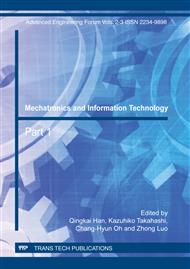p.519
p.523
p.527
p.531
p.535
p.541
p.547
p.553
p.559
Vibration Control and Dynamical Model of a Thermal-Electrical-Mechanical Coupled Smart Cantilevered Beam
Abstract:
Piezoelectric actuators used in vibration control and high precision control have been known widely in recent years. Especially in aeronautics and MEMS systems, their use is spread from vibration suppression to position control. In this paper, a finite element model (FEM) of a piezoelectric actuator and cantilever in thermal environment is presented to suppress vibration effectively. In other words, the finite element model is namely thermal-electrical-mechanical coupled FEM. Based on a 8-node plane finite element, the modal analysis, the harmonic analysis and the transient analysis have been obtained in the current work. Therefore a transfer function model will be attained through the harmonic analysis by identification method in order to control vibration by control law. In addition, the controller will be designed with the adaptive pole placement control (APPC). Finally, through simulation, the thermal influence is considerable for natural frequencies, harmonic response and free vibration. Moreover, the APPC is a significant plan to vibration control in the paper.
Info:
Periodical:
Pages:
535-540
Citation:
Online since:
December 2011
Authors:
Permissions:
Share:
Citation:


